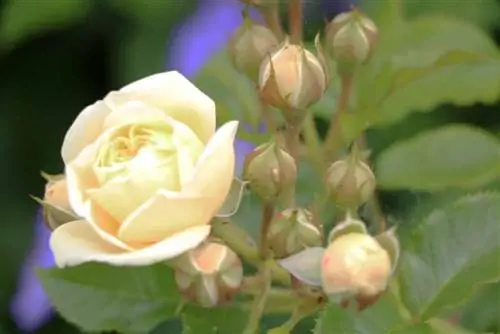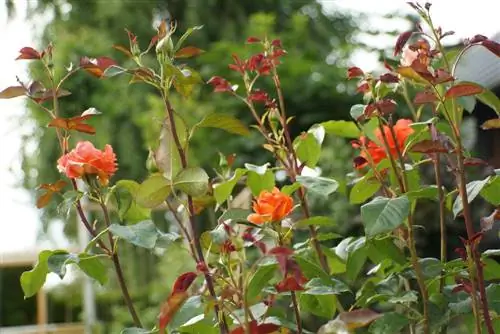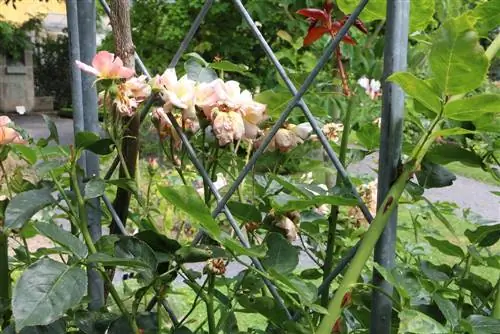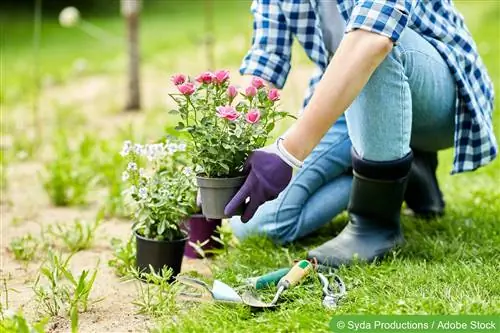- Author admin [email protected].
- Public 2023-12-17 03:39.
- Last modified 2025-01-24 12:45.
Roses become more and more magnificent every year. Their canes can produce new shoots for decades and give us beautiful rose petals. But what do you do if you have to move during your long life? Be it that the old place has become too small or doesn't really suit her. Can roses cope with the move? And if so, how can this be optimally designed?
Can roses be moved?
Sometimes the rose plant just doesn't thrive in the space allotted to it. If no care measures help and the rose only shows stunted growth, a change of location could be worth a try. However, what about roses that are well-filled in their current location. Is it better to leave them alone or can they be transplanted safely? Some plants don't like it at all when they have to pull their roots out of their usual soil and move to a new location. Fortunately, the rose is not one of the sensitive plants in this respect. However, a few rules must be followed when moving so that it grows well in the new soil and will soon delight you with its flower heads.
The age of the rose plays a role
How successful the transplanting will be depends partly on the age of the rose. The older a rose is, the more roots it has formed over its long life. These may reach deep into the earth, far deeper than the spade can reach. Digging out these roots in a way that minimizes damage to them is the main challenge when transplanting.
- young roses are easy to dig up
- adult roses, five years and older, require more effort
- old roses can hardly be dug up with hands and spades
Hedge roses, climbing roses and historical roses that have already had several years of life behind them are more difficult to transplant. Excavating their roots undamaged and to their full extent is very labor intensive. A spade alone may not be enough. You may even need a small excavator to uncover the roots. The extent to which this effort should be made is up to the rose owner.
Tip:
For valuable roses that cannot be easily purchased and transplanting is difficult, it may be worth propagating them using cuttings.
Autumn is the best season

A rose doesn't always have to be moved immediately. If there is still time, it is worth waiting until autumn. This is the time of year when transplanting roses is most successful.
- transplant from October
- before the first frosts come
The still mild temperatures above freezing are optimal for the transplanted rose to take root quickly.
Spring is the second choice
If the rose absolutely has to leave its place and cannot wait until autumn, spring is an alternative planting time. However, the weather in spring in this country can occasionally be moody. It may well be that the temperatures unexpectedly climb to summer levels for days or even weeks. The heat is a stress factor for the transplanted rose. Keep an eye on it and always provide the plant with enough water.
- Prevent dehydration
- always water enough with water
- protect from the blazing midday sun
In summer only if necessary
If the rose has to be moved from its old place in the middle of summer and time is of the essence, it doesn't have to end up on the compost heap. Although summer is not the ideal season for transplanting roses, the situation is not completely hopeless. The rose has to adapt to the new environment under difficult conditions because the hot temperatures cause it stress. It is therefore important that it is not exposed to the blazing midday sun and that the soil never dries out completely.
Alternative: bucket as a stopover
A rose does not have to move to a new place in the bed immediately. It is certainly possible to temporarily plant them in a large container.
- especially suitable in summer
- for small and medium-sized rose bushes
- the bucket is mobile and can be placed in the shade
- Ailing roses can be cared for better
- move to their permanent location in the fall
Rose roots grow straight down

Before digging up the rose, it is important to know that the roots of this flower usually grow straight down. An exception are the historic roses that are planted without roots and form runners. Apart from that, the rootstock is located directly below the shoots. This makes it easier to dig out the roots without damaging them.
Instructions for the implementation
Below you will find the detailed instructions for successfully moving roses:
Prepare the new planting hole
So that the dug up rose can move to its new home immediately, the new planting hole should be prepared and waiting for it. This way the dug up rose doesn't have to wait in the air.
- loose up the soil thoroughly and thoroughly
- Roots grow more easily in loosened soil
- Dig planting hole
- do not put fertilizer in the planting hole
- It is better to replace unsuitable soil with special rose soil
Tip:
The new location should offer the rose plenty of sun and sandy-loamy soil.
Cut back rose shoots vigorously
Every shoot of the rose must be well cared for throughout so that it grows optimally. It needs water and nutrients, which are supplied to it by the roots in the soil. However, when transplanting, many fine roots are damaged and the supply for the long shoots is no longer sufficiently ensured. It takes a few weeks for the rhizome to recover.
- cut back all above-ground shoots of the rose
- at a length of about 40 cm
- use clean secateurs
Dig up the rose carefully
After shortening, the rose bush can be dug up. This should be done carefully in order to damage as few roots as possible.
- The easiest way to do this is with a spade
- Prick deep into the soil around young roses
- work in several steps for older and large roses
- first dig a trench around the rose
- then pierce the soil all around the roots
- Clean roots that are too long with a spade
- lost root mass grows back in the new location
- After circling, carefully lift the rose bush with the spade
- Remove the root ball completely from the bed
Cutting back roots

The more roots remain on the rhizome, the better the plant can be supplied with the nutrients and water it needs. Unfortunately, even when digging carefully, some roots are damaged.
- shorten damaged roots
- use clean and disinfected secateurs
- leave intact roots
Move rose
The dug up rose should be moved into the prepared plant hole as quickly as possible so that the roots are not exposed to dry air for a long time.
- Put the rose straight into the planting hole
- thickened area should be in the planting hole
- about three to five centimeters below the ground surface
- Fill the planting hole completely with excavated soil
Tip:
If the rose cannot be replanted immediately, it should spend the waiting time in the shade and in a bucket of water.
Water the rose abundantly
The transplanted rose needs plenty of water because it cannot provide itself sufficiently at the beginning. Immediately after transplanting, give her 10 liters and maintain regular watering for the first few weeks. However, always water depending on the current weather conditions. Especially if the rose bush was transplanted in spring or summer, the water requirement is higher than if it was transplanted in autumn.
Pile up a protective layer of soil
The transplanted rose needs protection against drying out. Therefore, it must be piled up immediately after planting and watering. Shovel plenty of soil around the rose until you have formed a mound. This should cover almost the entire plant.
- always pile up, no matter what time of year it is transplanted
- only the tips of the shoots are allowed to show out
- leave the mound for two to three months if possible
- only then can the rose bush be freed from the earth again
- or just let the rain gradually erode the hill
- When planted in autumn, the rose should remain piled up until spring






